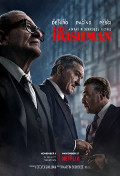
Directed by
Martin Scorsese
210 minutes
Rated MA
Reviewed by
Bernard Hemingway

The Irishman
Synopsis: The story of how Frank Sheeran (Robert De Niro) got involved in organized crime in post-war America and eventually killed infamous Teamster boss Jimmy Hoffa (Al Pacino).
Both Martin Scorsese and his long-time collaborator Robert De Niro are in their mid-seventies so The Irishman is likely to be their final partnership (they get the top two producer credits) and the capstone of their fascination with Mob culture which started with Mean Streets in 1973. This goes a long way to explaining the fastidious attention to detail and sombre tone of a film which spanning as it does over half a century one feels is Scorsese’s attempt to match Coppola’s epic Godfather trilogy in one movie.
Scripted by A-list screenwriter Steve Zaillian (he won an Oscar for Schindler’s List in 1993) working from a book by Charles Brandt called ‘l Heard You Paint Houses’ the film take three-and-a-half hours to tell the story of how Frank progressed from being a truck-driving World War II veteran to working for the Mafia during which time he formed a long-standing relationship with notorious union boss Jimmy Hoffa who, according to Frank at least, he eventually executed on Mob orders.
Whilst the first part of the film, which is largely devoted to Frank’s rise over the years in the Mob, is very much in the familiar manner of mobster thuggery already showcased in Goodfellas (1990) and Casino (1995) with cinematographer Rodrigo Prieto steeped in Gordon Willis-style low lit visuals, the second part is devoted to Frank’s relationship with Hoffa and the involvement of the Mob in American politics in the 1960s and ‘70s. Exactly why so much screentime is given to this part of the story is not clear as it tends to drag with the links between Frank and the historical events feeling too tenuous to carry any dramatic weight. Long-time Scorsese editor Thelma Schoonmaker could have put her scissors to use without anyone feeling deprived.
Opening with nursing home inmate Frank telling his story to an unknown listener the film then flashes back in time where it largely stays, mainly between the late 1940s and late 1970s, intermittently jumping back to the present. Being Scorsese you’d expect exemplary production values and you won’t be disappointed. The costume design, art direction and so on are top-notch and all this is buffed up with a varied roster of pop songs of the era with The Five Satins' ‘In the Still Of The Night’ standing out, its doo wop cheesiness contributing to the gallows humour which peppers the film (for example when Frank is off to kill Hoffa Zaillian drops in a Tarantino-esque exchange about fish).
If Scorsese looks after the packaging what really compels our attention are the actors. Whilst much noise has been made about the “de-aging” of the players this isn’t entirely effective. Not only do their faces have a waxy mask-like pallor, their body language doesn’t have age-appropriate flexibility, This aside, although he never appears to be remotely Irish, De Niro is in fine form as the hit man increasingly eaten away by his sins (there is a suggestion that he acquired his ability to murder without qualm during the WWII) whilst Joe Pesci is highly effective as Frank’s quietly ruthless boss. Harvey Keitel only appears briefly in a couple of scenes but Pacino chews the scenery like there is no tomorrow and an Improbable Ray Romano acquits himself well as a Mob lawyer. Other than a couple of scenes for Katherine Narducci as Pesci’s wife and a few words of dialogue from Anna Paquin as Frank’s daughter there is negligible female presence in the film
If much of The Irishman is familiar fare, albeit very well done, it is at its best in its later stages when it brings to a head the question which is suggested every now and then by the silent observations of Frank’s daughter who as she grows up comes to realize what her father does for a living – what was it all for? It’s a question which ties this film to Scorsese’seemingly very different The Last Temptation of Christ (1988) and ultimately to Coppola’s trilogy.

Want more about this film?


Want something different?




